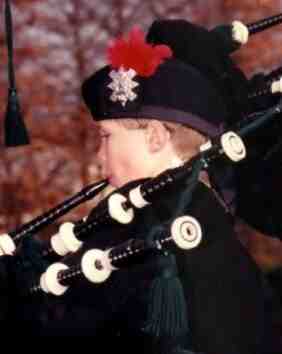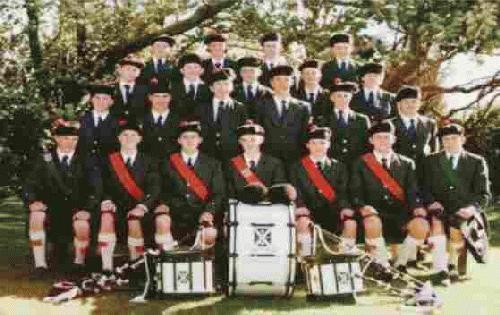
Figure 1.--The Scottish Great Pipes are the bagpipes used by most pipebands around the world.


Figure 1.--The Scottish Great Pipes are the bagpipes used by most pipebands around the world. |
Bagpipes exist in many forms and are found in Scotland, Ireland,
Russia, Finland, Germany, France, Spain, and in many other places
around the world. In each country the basic instrument is the same, a
bag with a chanter and possibly one or more drones. Some of these
are mouth blown while others use a bellows attachment to supply the
air. It is with Scotland and Ireland, however that bagpipes and the
modern pipe band are most associated.
There are two basic types of bagpipes, Scottish and Irish.
The Scottish highland pipe is the best known and most common bagpipe. Most people when they think of bagpipes are thinking about the Scottish Highland pipes. The Higland pipes are a relatively recebt origin. The
Roman legions that fought the higland tribes and belt Hadrians Wall to protect themselves, never faced the pipes. The Gaelic-speaking peoples of the Scottish Highlands and western islands of Scotland
developed them from roughly the 1500's to 1800's.
The modern form of the Higland bagpipe consists of 1 loud, high-pitched pipe or "chanter" plays the tune from a small fixed scale of 9 notes, 3 big, loud upright pipes or "drones" which play a single constant
bass/treble tone, all connected to a bag held under the arm and filled with air blown by
mouth through a "blow-pipe." The drones are tuned approximately to B-flat, with the scale being roughly a Mixolydian
mode scale having "normal" or major-key notes except for the 7ths ("ti" in the "do-re-mi"
scale), which are flat or minor-key. The chanter notes are not called by these names. They
are named for notes which are actually 1/2 step lower than this, that is the B-flat is termed by
pipers an "A." The scale runs one octave from A to A but also includes one note below the
scale, a 7th or G. The exact tuning between each of the notes has varied over the years but
has never been a tempered (orchestral) scale, but rather is meant to blend best with the
ever-present drone. Evidently this scale was developed to play 5-note or pentatonic music against the fixed
drone in several modes.
The major feature of the Highland pipes is a leather bag encased in
a decorative velvet cover. The top of the bag has "stocks" or short
wooden sockets into which all the pipes fit. A drone fitted with a reed
is inserted in the stock. A chanter has finger holes. There are several
dark bands on the chanter. They are small pieces of tape which are used
to tune certain notes by partly covering their holes. Chanters have
double-reeds. Drones have sound-holes.
Boys often lear on small practice chanters. A small practice-chanter
is a learning and study instrument. It is usually equipped with small
plastic reeds.

Figure 2.--. |
People around the world have long been fascinated by the bagpipes
chief characteristic--continuous sound. Bagpipes are
among the earliest inventions capable of producing continuous sound.
The unchanging drone accompaniment
is also an ancient aspect of the music of many cultures. To this day it
is used to express strong emotions in passages of popular music, jazz,
orchestral music and background music for TV and motion pictures.
The bagpipe is loud because of its long history of use first in the
medieval clan society of the
Highlands and later in the British military, playing outdoors to announce
gatherings and to
inspire soldiers in battle. It can be heard for 1 or 2 miles over land or
sea under some
conditions. However it is very quiet compared to modern amplified
instruments, and usually
requires amplification when playing in small folk or rock bands.
Anciently the pipes played slow, lengthy pieces now known as "piobaireachd" or pibroch
(PEE-brock) or piper-stuff. The pipes were always played solo in those times. With the
collapse of the Highland clan society the original utility and audience for this music vanished
and so it lives on primarily as a classical form rarely heard except among pipers and small
numbers of pipe music lovers.
Brutal British military action after the disastrous Battle of Cloden in
173? brought traditional clan society toman end. The bagpipe might have
become rare or extinct. The British Army, however, recruited large
numbers of Highlanders. Some formerly bitter foes of the English joined
the British Army. The suppresion of the Higland clans left few other
opportunnities. Ironically, it was only in the Army that vestages of Scottish
culture were permitted. Scotts were prohibited from wearing kilts or
playing the pipes. This was allowed only in the Army. The British found
the pipes useful. With a new repertoire of work songs, folk songs and dance tunes adapted for marching,
signalling, and inspiring & entertaining troops. This newer music had predictable form and
tempo, allowing numerous pipers to play together and to be accompanied by drums for
marching. Thus was born the modern pipe band or pipes-and-drums.

Figure 3.--This boy's pipeband at a New Zealand school also uses the Higlands Great Pipes. Drums introduced by the English are an important feature of the modern pipe band. |
Today bagpipes, like many ancient instruments from many cultures, have been incorporated
into stage bands with a variety of modern instruments and are adopting new forms of music
and new styles of playing. The Highland pipes are becoming popular so quickly now that
most pipers who have ever played are alive and playing today.
The Irish pipes are probably the most elaborate bagpipe in the
world. Uillean pipes were developed from roughly the
1700's to the present time in Ireland, with contributions from the
United States and European
countries. Today it is widely known as the "uilleann" (ILL-en) pipe
from the Gaelic word for
"elbow" but it has earlier been called variously the "union" pipe and the
"organ" pipe. Some
writers believe there to be only one correct term for the instrument but
language and usage change with time.
Unlike many types of bagpipe, the uilleann pipes are not blown by mouth
but, like numerous types of bagpipes, are inflated by a bellows. Perhaps
the most important feature of the
instrument is its melody-pipe or chanter, which plays more than two
complete chromatic
octaves (most forms of bagpipe can play little more than one octave).
The chanter is essentially a primitive oboe and is very quiet, about
as loud as 1-2 fiddles.
Like the Scots Highland bagpipe the uilleann pipes have 3 drones but they
are very quiet.
One of the most unusual features of the instrument is the set of
(typically) 3 more oboes in
the form of 1-octave, 4- or 5-note stopped harmony pipes with keys
operated by the wrist
(while the piper fingers the melody on the chanter) to provide several
simple chords for
accompaniment. These pipes have the peculiar name of "regulators" although
they are purely
musical and do not in any way "regulate" air pressure or behavior of the
instrument.
The most commonly-heard or "concert pitch" pipes are tuned in the key of D. The drones
are all tuned to D and the chanter plays 2 chromatic octaves (or more) starting with a D.
Anciently the pipes were set to lower pitches, and a small number of instruments are
regularly heard in keys of C#, B and B-flat. These are generally quieter and are most often
played solo since it is somewhat difficult for other common Irish instruments to tune to them.
The instrument must be played seated with one leg lowered. The chanter bottom is placed
onto this leg to seal the opening shut, so that the piper can play either continuously or, as
desired, can stop the chanter to play interrupted or stacatto notes. Click here (84 KB) to
see a photo of a full set of Irish uilleann pipes being played.

Figure 4.--. bands. |
The chanter of the uilleann pipes (or their ancestor) seems to date to about the time of
invention of the modern oboe. Whereas most varieties of bagpipe retained their traditional
form as classical music evolved, uilleann pipers embraced a great deal of innovation in their
instrument. The oboe's 2nd octave and full chromatic scales were first adopted. The drones
were fitted with a stop-valve so that they could be turned off when playing in keys for which
they would be undesireable.
The regulators provided a simple but much wider variety of harmonic accompaniment than
the drones. Uilleann pipes have continued to evolve in the modern era, responding to the
needs of stage playing in the days of Vaudeville with louder sound and higher pitch.
Increasing demands for precise tuning in the modern era of digital music have produced
instruments which can hold their own very well in music other than traditional Irish music.
Related Chronolgy Pages in the Boys' Historical Web Site
[Main Chronology Page]
[The 1880s]
[The 1930s]
[The 1940s]
[The 1950s]
[The 1960s]
[The 1970s]
[The 1980s]
Navigate the Historic Boys' Clothing Web style pages:
[Kilts]
[Caps]
[Sailor suits]
[Sailor hats]
[School uniform
[Scout
